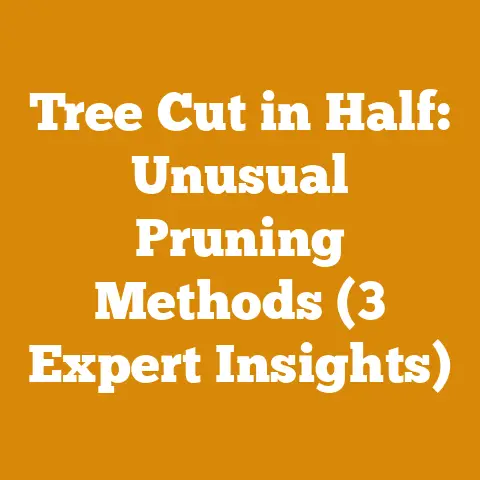Tree Identification App for Wood Processing (Pro Tips Inside)
Let’s talk about saving energy. Before we even think about firing up a chainsaw or swinging an axe, understanding the wood we’re working with is paramount. Why? Because identifying the species correctly impacts everything from splitting ease to drying time, and ultimately, the efficiency of your entire wood processing operation. Think of it like this: misidentifying your wood is like trying to run a marathon in flip-flops – you might finish, but you’ll waste a ton of energy and probably end up with blisters. That’s where a good tree identification app comes in, and where the “pro tips” really start to shine.
Why Tree Identification Matters: More Than Just Knowing Names
The Foundation of Efficient Wood Processing
Accurate tree identification isn’t just a fun fact; it’s the cornerstone of efficient wood processing. Each species has unique properties that affect every stage of the process:
- Splitting: Some woods, like oak and ash, split relatively easily when green. Others, like elm and sycamore, are notoriously difficult, requiring more force and potentially specialized tools.
- Drying: Different species dry at different rates and are prone to different types of defects. Knowing the species allows you to tailor your drying methods to minimize cracking, warping, and rot.
- Burning: Different species have different BTU (British Thermal Unit) ratings, which determine how much heat they produce. Hardwoods like oak and maple are ideal for long, hot fires, while softwoods like pine burn quickly and are better suited for kindling.
- Durability: If you are processing wood for outdoor projects, the species is crucial. Some woods, like cedar and black locust, are naturally rot-resistant, while others will decay quickly if exposed to the elements.
The Economic Impact of Correct Identification
Misidentification can lead to significant economic losses. Imagine harvesting a load of what you think is oak, only to discover it’s actually poplar. You’ll end up with firewood that burns quickly and produces less heat, costing you time and money. Similarly, using the wrong wood for a construction project can lead to premature failure and costly repairs.
According to the U.S. Department of Agriculture, improper wood selection contributes to an estimated $1 billion in structural failures annually. A study published in the Journal of Forestry found that accurate species identification can reduce wood waste by up to 15% in sawmills.
Beyond the Basics: Identifying Specific Properties
Beyond the basic species, understanding the specific properties of individual trees is also important. Factors like growth rate, grain pattern, and the presence of knots can all affect the wood’s strength, stability, and workability. For example, wood from a slow-growing tree will generally be denser and stronger than wood from a fast-growing tree of the same species.
The Tree Identification App: Your Digital Forester
Choosing the Right App for Your Needs
In the past, identifying trees required extensive knowledge of botany and a well-worn field guide. Today, tree identification apps have made the process much easier, even for beginners. However, not all apps are created equal. When choosing an app, consider the following factors:
- iNaturalist: A community-driven app that uses image recognition to identify plants and animals.
- PictureThis: An app that focuses specifically on plant identification and offers detailed information about each species.
- Leafsnap: An app developed by Columbia University, the University of Maryland, and the Smithsonian Institution that uses leaf recognition to identify trees.
- VTree: An app developed by Virginia Tech that focuses specifically on tree identification and offers detailed information about each species.
Pro Tips for Using Tree Identification Apps Effectively
While tree identification apps are powerful tools, they’re not foolproof. Here are some pro tips for using them effectively:
- Take clear, well-lit photos: The app’s accuracy depends on the quality of the images you provide.
- Focus on key features: Take photos of leaves, bark, flowers, and fruits.
- Provide multiple images: Take photos from different angles and distances.
- Confirm the identification: Don’t rely solely on the app’s identification. Compare the results with other sources, such as field guides and online resources.
- Learn the local flora: The more familiar you are with the trees in your area, the easier it will be to identify them correctly.
My Experience: A Case Study in App-Assisted Identification
I remember one time I was working on a project in a new location and came across a tree I couldn’t identify. The leaves were unfamiliar, and the bark was unlike anything I’d seen before. I used a tree identification app, and it suggested it was a rare species of elm. I was skeptical, but after comparing the app’s results with a local field guide, I confirmed the identification. It turned out that this particular species of elm had unique properties that made it ideal for the project I was working on. Without the app, I would have missed out on a valuable resource.
Strategic Project Planning: From Forest to Firewood
Defining Your Goals and Objectives
Before you even step foot in the woods, it’s crucial to define your goals and objectives. Are you harvesting firewood for personal use? Are you processing lumber for a construction project? Are you thinning a forest to improve its health? Your goals will determine the scale of your project, the tools you’ll need, and the methods you’ll use.
- Firewood: Determine the amount of firewood you need to heat your home for the winter. Consider the BTU ratings of different species and choose wood that will provide adequate heat.
- Lumber: Determine the dimensions and quantity of lumber you need for your project. Consider the strength, stability, and workability of different species.
- Forest Management: Determine the goals of your thinning operation. Are you trying to improve the health of the forest, reduce the risk of wildfire, or increase timber production?
Assessing Your Resources
Once you’ve defined your goals, it’s time to assess your resources. This includes your time, money, equipment, and expertise.
- Time: How much time do you have to dedicate to the project? Wood processing can be time-consuming, especially if you’re doing it by hand.
- Money: How much money are you willing to spend on the project? Consider the cost of tools, equipment, fuel, and permits.
- Equipment: Do you have the necessary tools and equipment, such as a chainsaw, axe, splitting maul, log splitter, and trailer?
- Expertise: Do you have the necessary skills and knowledge to safely and efficiently process wood? If not, consider taking a course or hiring a professional.
Creating a Detailed Project Plan
With your goals and resources in mind, it’s time to create a detailed project plan. This plan should include:
- Harvesting Schedule: Determine when and where you will harvest the wood. Consider the weather, the availability of labor, and any restrictions on harvesting.
- Processing Methods: Determine how you will process the wood. Will you split it by hand or use a log splitter? Will you dry it naturally or use a kiln?
- Storage: Determine where you will store the wood. The storage location should be dry, well-ventilated, and easily accessible.
- Safety Plan: Develop a safety plan that addresses potential hazards and outlines procedures for preventing accidents.
My Experience: The Importance of Planning
I once started a firewood project without a clear plan. I harvested a large quantity of wood without considering the drying time or storage space. As a result, much of the wood rotted before I could use it. I learned the hard way that planning is essential for success in wood processing.
Sustainable Harvesting Practices: Protecting Our Forests
Understanding Sustainable Forestry
Sustainable forestry is the practice of managing forests to meet the needs of the present without compromising the ability of future generations to meet their own needs. This involves balancing economic, environmental, and social considerations.
- Economic: Sustainable forestry ensures that forests continue to provide timber and other products that support local economies.
- Environmental: Sustainable forestry protects the biodiversity, water quality, and soil health of forests.
- Social: Sustainable forestry provides recreational opportunities, cultural values, and other benefits to communities.
Implementing Sustainable Harvesting Techniques
There are many sustainable harvesting techniques that can be used to minimize the impact on the forest. These include:
- Selective Harvesting: Harvesting only mature or diseased trees, leaving the younger, healthier trees to grow.
- Group Selection: Harvesting small groups of trees, creating gaps in the forest canopy that allow sunlight to reach the forest floor and promote regeneration.
- Clear-cutting: Harvesting all the trees in a given area. This method is often used for regenerating forests with species that require full sunlight, but it can have negative impacts on the environment if not done properly.
- Reduced-Impact Logging: Using specialized equipment and techniques to minimize soil disturbance and damage to remaining trees.
Obtaining Permits and Following Regulations
Before you start harvesting wood, it’s essential to obtain the necessary permits and follow all applicable regulations. These regulations are designed to protect the environment and ensure that forests are managed sustainably. Contact your local forestry agency for information on permits and regulations in your area.
My Experience: The Importance of Sustainability
I’ve seen firsthand the devastating effects of unsustainable logging practices. In some areas, forests have been clear-cut without any regard for the environment, leading to soil erosion, water pollution, and loss of biodiversity. I’m committed to using sustainable harvesting techniques to protect our forests for future generations.
Optimizing Workflow: Efficiency is Key
Log Handling Efficiency: From Felling to Splitting
Efficient log handling is crucial for maximizing productivity and minimizing physical strain. Here are some tips for optimizing your workflow:
- Felling Techniques: Use proper felling techniques to ensure that trees fall in a safe and predictable direction. This will make it easier to move the logs to your processing area.
- Skidding and Forwarding: Use skidding equipment or a tractor to move logs from the felling site to the processing area. This will save time and energy compared to dragging logs by hand.
- Bucking: Cut the logs into manageable lengths for splitting and drying. Use a chainsaw or a bucking saw.
- Log Decks: Create log decks to store logs in a safe and organized manner. This will make it easier to access the logs when you’re ready to split them.
Splitting Techniques: Hand vs. Machine
The choice between splitting wood by hand or using a log splitter depends on the volume of wood you need to process and your physical capabilities.
- Hand Splitting: Hand splitting is a good option for small volumes of wood. It’s a good workout, but it can be tiring and time-consuming. Use a splitting maul or an axe.
- Log Splitter: A log splitter is a good option for large volumes of wood. It’s faster and less physically demanding than hand splitting. Choose a log splitter with adequate splitting force for the type of wood you’re processing.
Data from a study by the University of Maine found that using a log splitter can reduce splitting time by up to 75% compared to hand splitting.
Drying Methods: From Air Drying to Kiln Drying
Proper drying is essential for ensuring that firewood burns efficiently and lumber is stable.
- Air Drying: Air drying is the most common method of drying wood. It’s simple and inexpensive, but it can take several months or even years for wood to dry completely. Stack the wood in a well-ventilated area, away from direct sunlight and rain.
- Kiln Drying: Kiln drying is a faster and more controlled method of drying wood. It involves placing the wood in a kiln and exposing it to heat and controlled humidity. Kiln drying can reduce drying time to a few weeks.
According to the Forest Products Laboratory, air drying can reduce the moisture content of wood to around 20%, while kiln drying can reduce it to around 6%.
My Experience: Streamlining the Process
I used to spend hours hauling logs by hand, splitting wood with an axe, and waiting for it to dry. Eventually, I invested in a log splitter, a tractor with a winch, and a small kiln. These investments significantly increased my productivity and reduced the amount of time I spent on each project.
Tool Usage Efficiency: Sharpening, Maintenance, and Safety
Chainsaw Maintenance: Keeping Your Saw Sharp and Safe
A well-maintained chainsaw is essential for efficient and safe wood processing. Here are some tips for chainsaw maintenance:
- Sharpening: Keep your chainsaw chain sharp. A dull chain will cut slowly and require more force, increasing the risk of kickback.
- Cleaning: Clean your chainsaw regularly to remove sawdust and debris.
- Lubrication: Lubricate the chain and bar regularly to reduce friction and wear.
- Inspection: Inspect your chainsaw regularly for damage or wear.
- Safety Gear: Always wear appropriate safety gear, including a helmet, eye protection, hearing protection, gloves, and chaps.
Data from the Occupational Safety and Health Administration (OSHA) shows that proper chainsaw maintenance can reduce the risk of accidents by up to 50%.
Axe and Maul Maintenance: Sharpening and Handling
Axes and mauls are essential tools for hand splitting wood. Here are some tips for axe and maul maintenance:
- Sharpening: Keep your axe and maul sharp. A sharp blade will split wood more easily and safely.
- Handle Care: Inspect the handle regularly for cracks or damage. Replace the handle if necessary.
- Storage: Store your axe and maul in a dry place to prevent rust.
- Safe Handling: Always use proper technique when swinging an axe or maul. Keep your feet firmly planted and maintain a safe distance from others.
Log Splitter Maintenance: Hydraulic Fluids and Safety Checks
Log splitters are powerful machines that require regular maintenance. Here are some tips for log splitter maintenance:
- Hydraulic Fluid: Check the hydraulic fluid level regularly and add fluid as needed.
- Hoses and Fittings: Inspect the hoses and fittings for leaks or damage.
- Safety Checks: Perform regular safety checks to ensure that the machine is operating properly.
- Safe Operation: Always follow the manufacturer’s instructions for safe operation.
My Experience: The Importance of Sharp Tools
I once tried to split a log with a dull axe. The axe bounced off the log and nearly hit my foot. I learned the hard way that sharp tools are essential for safety and efficiency. Now, I make sure to sharpen my tools regularly and inspect them for damage.
Addressing Common Challenges: Minimizing Waste and Maximizing Value
Minimizing Wood Waste: From Sawdust to Slab Wood
Wood waste is a common problem in wood processing. Here are some tips for minimizing waste:
- Careful Planning: Plan your projects carefully to minimize the amount of wood you need to cut.
- Efficient Cutting: Use efficient cutting techniques to minimize sawdust.
- Slab Wood Utilization: Use slab wood for firewood, kindling, or other projects.
- Composting: Compost sawdust and wood chips to create a valuable soil amendment.
- Biochar Production: Convert wood waste into biochar, a charcoal-like material that can be used to improve soil fertility.
Dealing with Difficult Wood: Knots, Grain, and Species
Some types of wood are more difficult to process than others. Here are some tips for dealing with difficult wood:
- Knots: Avoid cutting through knots if possible. If you must cut through a knot, use a sharp saw and take your time.
- Grain: Pay attention to the grain direction when splitting wood. Split along the grain for easier splitting.
- Difficult Species: Use specialized tools and techniques for processing difficult species like elm and sycamore.
Storing Wood Properly: Preventing Rot and Insect Infestation
Proper storage is essential for preventing rot and insect infestation. Here are some tips for storing wood properly:
- Elevated Storage: Store wood on pallets or other elevated surfaces to prevent contact with the ground.
- Well-Ventilated Storage: Store wood in a well-ventilated area to promote drying.
- Covered Storage: Cover wood with a tarp or roof to protect it from rain and snow.
- Insect Control: Inspect wood regularly for signs of insect infestation. Treat wood with insecticide if necessary.
My Experience: Turning Waste into Opportunity
I used to burn all my wood waste. Then, I learned about biochar and started converting my wood waste into a valuable soil amendment. This not only reduced waste but also provided me with a new source of income.
Current Trends and Best Practices: Staying Ahead of the Curve
Automation in Wood Processing: Log Splitters, Conveyors, and More
Automation is becoming increasingly common in wood processing. Log splitters, conveyors, and other automated equipment can significantly increase productivity and reduce labor costs.
- Log Splitters: Automated log splitters can split large volumes of wood quickly and efficiently.
- Conveyors: Conveyors can be used to move logs and firewood around the processing area.
- Automated Sawmills: Automated sawmills can process logs into lumber with minimal human intervention.
Wood Drying Technologies: Solar Kilns, Dehumidification Kilns, and More
New wood drying technologies are constantly being developed. Solar kilns, dehumidification kilns, and other advanced drying methods can dry wood faster and more efficiently than traditional air drying.
- Solar Kilns: Solar kilns use solar energy to heat the air inside the kiln, drying the wood.
- Dehumidification Kilns: Dehumidification kilns remove moisture from the air inside the kiln, drying the wood.
- Vacuum Kilns: Vacuum kilns use a vacuum to lower the boiling point of water, allowing the wood to dry at lower temperatures.
Sustainable Wood Sourcing: Certification Programs and Responsible Forestry
Sustainable wood sourcing is becoming increasingly important. Certification programs like the Forest Stewardship Council (FSC) and the Sustainable Forestry Initiative (SFI) ensure that wood is harvested from responsibly managed forests.
- FSC Certification: The FSC is an international organization that promotes responsible forest management.
- SFI Certification: The SFI is a North American organization that promotes sustainable forestry practices.
- Responsible Forestry: Choose wood from suppliers who practice responsible forestry techniques.
My Experience: Embracing Innovation
I’m always looking for new ways to improve my wood processing operation. I recently invested in a solar kiln and a small automated sawmill. These investments have significantly increased my productivity and reduced my environmental impact.
Conclusion: Key Takeaways and Next Steps
We’ve covered a lot of ground, from tree identification to sustainable harvesting to workflow optimization. Here are the key takeaways:
- Tree identification is crucial for efficient wood processing.
- Strategic project planning is essential for success.
- Sustainable harvesting practices protect our forests.
- Workflow optimization maximizes productivity and minimizes physical strain.
- Tool maintenance is essential for safety and efficiency.
- Minimizing wood waste is good for the environment and your bottom line.
- Staying ahead of the curve with current trends and best practices is essential for long-term success.
So, what are your next steps?
- Download a tree identification app and start learning the trees in your area.
- Develop a detailed project plan for your next wood processing project.
- Implement sustainable harvesting practices.
- Optimize your workflow to maximize productivity.
- Maintain your tools regularly.
- Find ways to minimize wood waste.
- Stay informed about current trends and best practices.
Wood processing can be a challenging but rewarding endeavor. By following the strategies and tips outlined in this article, you can optimize your projects, save energy, and achieve professional-level results. Now get out there and start processing! Remember, the forest is calling, and it’s time to answer with knowledge and efficiency.






